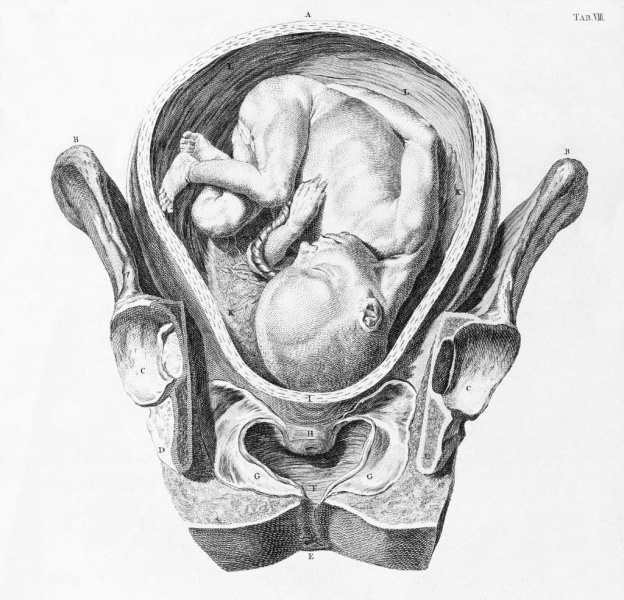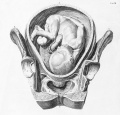File:Smellie1754 table08.jpg

Original file (1,024 × 984 pixels, file size: 265 KB, MIME type: image/jpeg)
Table 8. Uterus sixth or seventh month of pregnancy
In the same view and section of the parts as in Table VI. is represented the Uterus of the former Table, in order to shew its contents, and the internal parts as they appear in the sixth or seventh month of pregnancy.
The fetal head of which is here represented (as well as of those in Table VI.) situated downwards at the inferior part of the uterus, and which I am apt to believe is the usual situation of the uterus when at rest and surrounded with a great quantity of waters, as the head is heavier than any other part. With respect to the situation of the body of the fatus, though the fore-parts are often turned towards the sides and posterior parts of the uterus, they are here, as well as in the foregoing Table, represented at the anterior part or fore wards, in order to shew them in a more distinct and picturesque manner.
From this Table may appear the difficulty of stretching the os uteri in flooding cases, even at this period, from the length and thickness of the neck of the womb, especially in a first pregnancy : Much the same method, however, is to be followed here as was directed in Table VI. till labour comes on to dilate the os uteri. If the flooding is then considerable, the membranes should be broken, that the uterus may contract, and thereby lessen the discharge. The labour likewise, if it is necessary, may be assisted by dilating the os uteri in time of the pains ; which also, if wanting, may be provoked by the same method, when the patient is in danger. If this danger is imminent, and the woman seems ready to expire, the uterus, as appears from this Table, is at this time sufficiently stretched to receive the operator's hand to extract the fcetus, if the os internum can be safely dilated.
Lastly, It may be observed that women are in greater danger at this period and afterwards, than in the former months.
Legend
- A The uterus stretched up to the umbilical region.
- B The superior part of the ossa ilium.
- C The acetabula.
- D The remaining posterior parts of the ossa ischium.
- E The anus.
- F The vagina.
- G The bladder of urine.
- H The neck of the womb shorter than in Table VI. and raised higher by the stretching of the uterus above the brim of the pelvis.
- I The vessels of the uterus larger than in the unimpregnated state.
- K The placenta adhering to the inferior and posterior part of the uterus.
- L The membranes that surround the foetus.
Vide Vol. I. Book I. Chap. 3. Sect. 3, 4. Vol. II. Coll. 13. No. 1.
Vide Vol. I. Book III. Chap. 4. Sect. 3. No. 1, 2, 3. Vol. III. Coll. S3. No. 2. See also in the Edinburgh Physical and Literary Observations, Art. xvii. the dissection of a woman with child, by Dr. Donald Monro, Physician at London,
| Historic Disclaimer - information about historic embryology pages |
|---|
| Pages where the terms "Historic" (textbooks, papers, people, recommendations) appear on this site, and sections within pages where this disclaimer appears, indicate that the content and scientific understanding are specific to the time of publication. This means that while some scientific descriptions are still accurate, the terminology and interpretation of the developmental mechanisms reflect the understanding at the time of original publication and those of the preceding periods, these terms, interpretations and recommendations may not reflect our current scientific understanding. (More? Embryology History | Historic Embryology Papers) |
File history
Click on a date/time to view the file as it appeared at that time.
| Date/Time | Thumbnail | Dimensions | User | Comment | |
|---|---|---|---|---|---|
| current | 12:24, 12 November 2012 |  | 1,024 × 984 (265 KB) | Z8600021 (talk | contribs) | {{Smellie1754}} |
You cannot overwrite this file.
File usage
The following page uses this file:
